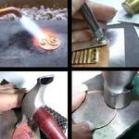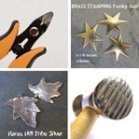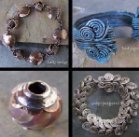Bubbles in patina
by Laura
(North Carolina)
Hi,
I am brand new to jewelry work. I'm using copper that I hand-stamp. I'm using LOS to patina, I've noticed on a few pieces small almost bubbles? Any idea what I'm doing wrong? Also do you have a tumbler you recommend?
Thank so much!
Laura :)
Stacy's Answer:
Hi Laura!
Welcome to the wonderful art of jewelry-making! It's hard to tell what may be going on with your stampings without actually seeing them. However, I have found that I get a more consistent patina finish if I polish the pieces first. This can be done on a buffing machine or using a flexshaft or dremel fitting with a buffing wheel and using a product such as ZAM or by tumble polishing.
There are many tumblers out there. Two brands that consistently produce good results and hold up well over time are the Lortone 3A and Thumbler-Tumbler 3 pound size. The 3-pound barrel capacities would probably work well for you. Both run in the $80-$100 range and for best results, you must also purchase Stainless steel shot to use in them. Most companies that sell the tumblers also carry the stainless steel shot for them. A Google search will probably help you find the best price.
Once your pieces are "finished" and nicely polished, then add your patina, remove any excess if you wish with a 3M scrubby-style pad or 0000 steel wool and then re-tumble for just an hour or so. Follow that up by buffing by hand with a jewelry polishing cloth such as Rio Grande's Sunshine cloth. It is possible that your patina did not go on evenly due to some sort of contamination on the metal such as wax, oil, etc. A good scrub using a very soft nylon brush, warm water and dish soap or a quick dip in super heated water also removes waxes etc. before adding a patina.
If you're going to add a lacquer sealant, after polishing and cleaning dip the piece in acetone to remove any oils, etc. (this does not affect the patina),let dry and then spray, dip or brush on your lacquer. If you notice any bubbles, rub them out before the lacquer sets and re-coat those areas. A Q-tip dipped in acetone works well for this. Once the lacquer is dry, your only options would be to sand away the offending bubbles and then re-apply the lacquer on those areas or to remove the lacquer completely (a laborious chore) and refinish the piece.
I've got a search engine bar on my website on the front page on the upper right-hand side to help folks find the information they're seeking. Simply "click" that bar and then type in what you are looking for like, lacquer coatings. All the threads that discuss using a lacquer will pop up for you to read. Have fun creating!!!
















